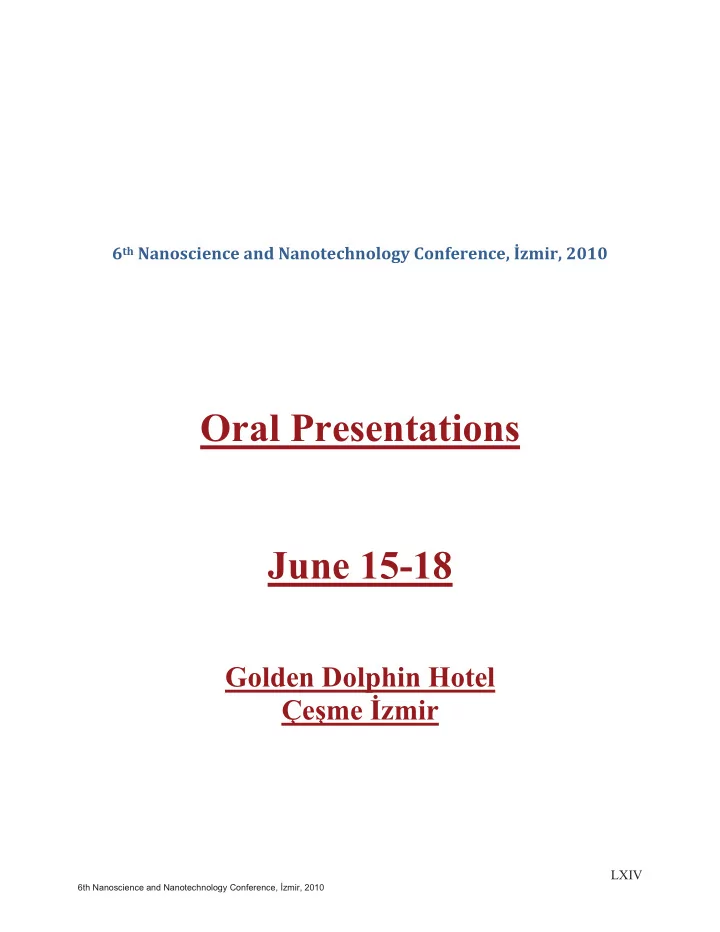

6 th Nanoscience and Nanotechnology Conference, İzmir, 2010 Oral Presentations June 15-18 Golden Dolphin Hotel Çeşme İzmir LXIV 6th Nanoscience and Nanotechnology Conference, İzmir, 2010
Oral Presentation, Theme A: Nanomaterials including Nanoparticles, Nanocavities, Nanocrystals, Nano-porous materials Production of CdO Nanoparticles from Cd(OH) 2 Precursor by Calcination Ahmet Avci, Volkan Eskizeybek, Okan Demir 1 Department of Mechanical Engineering, Selcuk University, Konya 42075, Turkey Abstract— In this study, cadmium hydroxide (Cd(OH) 2 ) nanowires were synthesized in yield by a simple arc-dischage method in de-ionized water. These precipitates were calcinated at 400 o C for 1 hour and CdO nanoparticles are formed. XRD and SEM, TEM were used to characterize the product, which revealed that the product consist of nanowires about 40 nm in diameter and nanodots about 20 nm in diameter. The X-ray diffraction study revealed that the as deposited particles consists of cadmium oxide (CdO) phase. Cadmium oxide is an n-type semiconductor with a direct b bandgap of 2.5 eV and an indirect bandgap of 1.98 eV [1]. a CdO nanostructures have low ohmic resistivity (even without doping) and high optical transmittance in the visible region of the solar spectrum along with amoderate refractive index (2.49) [2] which offer promising applications in optoelectric fields such as photovoltaic cells, photo-diodes, photo- transistors, gas sensors and transparent electrodes [3]. For these applications, particle size, porosity, and specific surface area are of major importance.Up to the present time, various one-dimensional CdO nanostructures such as nanowires, nanoneedles, nanobelts and nanorods have been synthesized by solid-state transformation metal-organic framework [4], vapor phase transport [5], template-assisted [6] and c d solvothermal methods [7]. In this work, Cd(OH) 2 nanowires were synthesized in de- ionized water by arc-dischage. High purity cadmium rods were used as anode and cathode. The arc discharge was initiated in the water by touching the anode to the cathode. The applied arc current of 50 A and the voltage 20-30 V were supplied by a dc. current welding power supply. The cadmium hydroxide particles dispersed in the water and some of them floated on the surface. After production, nanoparticles were were characterized by TEM (JEOL 2100 HRTEM) and X-ray Diffraction analysis (Shimadzu XRD - 6000). As seen in Figure 1-a, cadmium nanowires are branced form and has 20-30 nm Figure1 . a) TEM image of Cd(OH) 2 nanowires b) XRD pattern of Cd(OH) 2 nanowires c) TEM diameters. XRD analsis prove that Cd(OH) 2 are in crystalline image of CdO nanodots d) XRD pattern of CdO nanodots form and can be indexed as the hexagonal Cd(OH)2 with cell *Corresponding author: aavci@selcuk.edu.tr constants a=3.49 2, c=4.71 2, which are consistent with its values in the literature (JCPDS 31-0228) as seen in Figure 1-b. [1] M. Ortega, G. Santana, A. Morales-Acevedo, Optoelectronic As produced nanoparticles then were heated up to 400 o C for 1 properties of CdO/Si hour and the same analysis were repeated. In figure 1-c, TEM photodetectors, Solid State Electron. 44 (2000) (1765). observations showed that new nanoparticles are especially [2] S.H. Wang, S.H. Yang, Spectroscopic characterization of the nanodot form after calcination. A few nanowires are also seen copper sulphide core/shell nanowires, Mater. Sci. Eng. C 16 (2001) o C five 37. during investigation. After calcination at 400 [3] F.A. Benko, F.P. Koffyberg, Quantum efficiency and optical �������������������������������������������������������������� transitions of CdO photoanodes, Solid State Commun. 57 (1986) 901. and 69.28 which are associated with (1 1 1), (2 0 0), (2 2 0), (3 [4] F. Zhang, F. Bei, J. Cao, X. Wang, The preparation of CdO 1 1) and (2 2 2) as seen in figure 1-d. The planes have d- nanowires from solidstate transformation of a layered metal-organic spacing values of 2.71, 2.35, 1.66, 1.42 and 1.36Å framework, J. Solid State Chem. 181 (2008) 143. respectively, corresponding to pure CdO crystalline phase. [5] T. Kuo, M.H. Huang, Gold-catalyzed low-temperature growth of The crystal lattice parameter was calculated from the cadmium oxide nanowires by vapor transport, J. Phys. Chem. B 110 crystallographical relations to be a = 4.698Å which is (2006) 13717. [6] Y.W.Wang, C.H. Liang, G.Z. Wang, T. Gao, S.X. Wang, J.C. consistent with the CdO ASTM value (card 05-0640), 4.695 Fan, L.D. Zhang, Preparation and characterization of ordered Å. semiconductor CdO nanowire arrays, J. Mater. Sci. Lett. 20 (2001) In summary, CdO nanodots and nanowires were 1687. producted by calcination of Cd(OH) 2 precursor. The XRD [7] N. Varghese, L.S. Panchakarla, M. Hanapi, A. Govindaraj, analysis prove the transformation of nanoparticles from C.N.R. Rao, Solvothermal synthesis of nanorods of ZnO, N-doped Cd(OH) 2 to CdO. ZnO and CdO, Mater. Res. Bull. 42 (2007) 2117. [ 1 6th Nanoscience and Nanotechnology Conference, �zmir, 2010
Recommend
More recommend